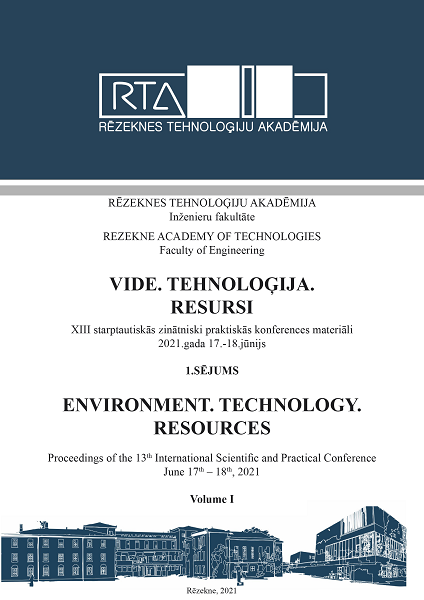ENERGY EFFICIENCY ASSESSMENT OF THE HOUSING STOCK IN BELARUSIAN REGIONS
DOI:
https://doi.org/10.17770/etr2021vol1.6520Keywords:
Energy efficiency, housing stock, regionAbstract
The need to ensure energy efficiency of the Belarusian economy at the present stage is justified. Indicators characterizing the level of fuel energy consumption and the impact of fuel consumption on the environment for the Belarusian regions are calculated. The authors found that Vitebsk region is characterized by high heat capacity Gross regional product. Also, Vitebsk region is characterized by a high volume of pollutant emissions into the air. We are talking about the emissions generated from fuel combustion for the production of heat and electricity. It has been substantiated that the main directions of regional development should be to reduce the consumption of fuel resources and the volume of emissions. The authors analyzed the structure of final consumption of fuel and energy resources by sectors of consumption, which showed that the main consumers of fuel and energy resources in Belarus are industry and housing sector.
In this article the highest priority has been given by authors to energy efficiency in housing sector. It is noted that improving the energy efficiency of the housing stock can reduce the energy load on the region. It is proposed to use a system of indicators to assess the level of energy efficiency. The scientific novelty is in the application of a systematic approach to assessing energy efficiency. Previous studies were limited to considering individual energy efficiency indicators, rather than their systems. It is proposed to include the following groups of indicators in the system: technical, financial and economic, environmental. In contrast to the previously proposed groups of indicators, the system developed by the authors includes environmental indicators. The relevance of their study is due to regional characteristics, which is especially important for the Vitebsk region.
The proposed system of indicators is able to give a holistic view of the level of energy efficiency of the housing stock. Thus, it becomes possible to identify reserves for the growth of energy efficiency in the housing sector in Belarus.
Downloads
References
Concept of the National Strategy for Sustainable Development of the Republic of Belarus for the period up to 2035 [Online]. Available: https://www.economy.gov.by/uploads/files/Obsug daemNPA/Kontseptsija-na-sajt.pdf [Accessed January 21, 2021].
Law of the Republic of Belarus “About energy saving” [Online]. Available: http://energoeffekt.gov.by/downloads/ laws/act/201501_law.pdf [Accessed January 21, 2021]
E. Volkov and V. Kostuk, “New technologies in the Russian electric power industry,” Bulletin of the Russian Academy of Sciences, vol.79, no. 8, pp. 675-686, 2009.
S. Voronin and A. Kalinin, “Energy saving”, Zernograd, Azov Black Sea State Agroengineering Academy, 256 p., 2009.
I. Galuzo, I. Potapov and I. Baydakov, “Experimental elective course “Fundamentals of Energy Efficiency” for schoolchildren,” Energy Efficiency, no. 8, 24 p., 2005.
V. Ganzha, “Fundamentals of efficient use of energy resources: theory and practice of energy saving,” Minsk, Belarusian. Science, 451 p., 2007.
T. Gulbrandsen, L. padalko and V. Chervinsky, “Energy efficiency and energy management: study guide,” Minsk, BGATU, 240 p., 2010.
T. Pospelova, “Fundamentals of energy saving,” Minsk, UP "Technoprint", 353 p., 2000.
N. Khaustovich, “Energy efficiency as an important condition for sustainable development of the country's economy,” Belarusian Economic Journal, no. 3, pp. 15-23, 2006.
R. Haas, “Energy efficiency indicators in the residential sector,” Energy Policy, no. 25 (7–9), pp. 789–802, 1997.
H. Herring and S. Sorrel, “Energy Efficiency and Sustainable Consumption: The Rebound Effect,” Hampshire, Palgrave Macmillan, 272 p., 2009.
T. R. Lakshmanan, P. Nijkamp and S. Ratick, “Integrated Models for Economic-Energy-Environmental Impact Analysis. Economic-Environmental-Energy Interactions: Modeling and Policy Analysis,” Springer Netherlands, pp. 7–39, 1980.
M. Patterson, “What is energy efficiency?” Energy Policy, no. 24(5), pp. 377-390, 1996.
A. H. Rosenfeld, “The Art of Energy Efficiency: Protecting the Environment with Better Technology,” Annual Review of Energy and Environment, no. 24, pp. 33–82, 1999.
A. H. Rosenfeld, “Real Prospects for Energy Efficiency in the United States, Chaired by Lester Lave and Maxine Savitz, America's Energy Future Panel on Energy Efficiency Technologies,” National Academy of Sciences, Academy of Engineering; The National Academies Press., 203 p., 2009.
V. Efremov, G. Markman “"Energy saving" and "energy efficiency": clarification of concepts, the system of balanced indicators e "energy efficiency",” Bulletin of the Tomsk Polytechnic University, no. 4, pp. 146-148, 2007.
A. Araslanov, “Formation of the mechanism of energy efficiency management of socio-economic systems of the region” [Online]. Available: https://esstu.ru/library/free/ Avtoreferat /% d0% 90% d1% 80% d0% b0% d1% 81% d0% bb% d0% b0% d0% bd% d0% be % d0% b2_% d0% a0_% d0% a4.pdf. [Accessed January 11, 2021].
I. Bashmakov, “Energy efficiency: from rhetoric to action” [Online]. Available: https://www.abok.ru/?controller=article AuthorView&id=1467 [Accessed December 12, 2020].
A. Gorshkov and A.Gladkikh, “Measures to improve energy efficiency in construction,” Construction sciences: building telophysics and energy saving, no. 3, pp. 246-250, 2010.
A. Tupikina, “Energy saving and increasing energy efficiency: a history of concepts,” Business. Education. Right. Bulletin of the Volgograd Institute of Business, no. 2, pp. 90-95, 2014.
“Energy efficiency” [Online]. Available: https://www.vsemi rnyjbank.org/ru/results/2017/12/01/energy-efficiency [Accessed March 1, 2021].
O. Seppanen, “Energy efficiency requirements for buildings in the EU” [Online]. Available: https://www.abok.ru/for_spec/ articles.php?nid=4739 [Accessed February 19, 2021].
R. S. Kaplan and D. P. Norton, “A balanced scorecard. From strategy to action,” Moscow, Olimp-Business, 304 p., 2003.
Energy balance of Belarus, 2020: statistical bulletin [Online]. Available: https://www.belstat.gov.by/ofitsialnaya-statistika/ realny-sector-ekonomiki/energeticheskaya-statistika /statisti cheskie-izdaniya/index_17875/ [Accessed December 21, 2020].



